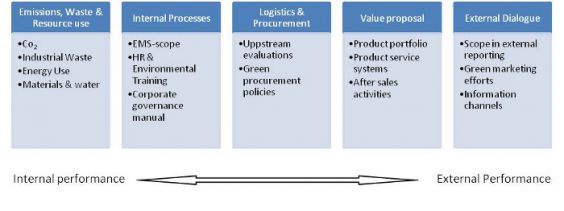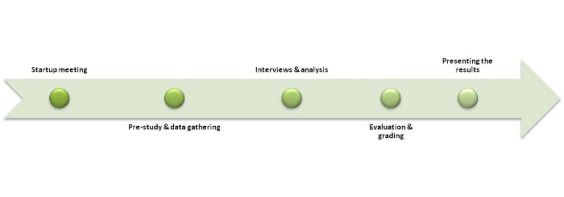Green Business Assessment - The link between environmental and company performance
Over the years the general attitude towards environmental management has shifted. From a reactive stance, in which accidents and release of pollutions were at the center stage, to a proactive one in which environmental performance is sometimes regarded as a vital factor for the success of the company. Better environmental performance may increase the competitive advantage of a company in numerous ways. For example, reduced waste and increased process efficiency may not only reduce the environmental load of a company but also reduce costs. Other interactions can be related to increased sales as a green business proposal target’s new niches with higher margins or less fierce competition. We believe interactions, such as the mentioned positive “spillover effect” is important for managers to consider whence formulating and evaluating their business strategy. However, existing methodologies and frameworks to evaluate environmental performance and business strategy generally evaluate on one aspect at the time and hence provide little guidance for managers on how to formulate strategies that results in these synergies. Environmental performance is generally evaluated separately by experts on environmental management in the same way as the corporate strategy is formulated by another group of experts. To evaluate these factors simultaneously requires both a model and method that integrates knowledge from both of these fields. In this article we will discuss a model and method that has been developed to help managers at smaller and medium sized firms.[1]
Conceptualizing environmental integration
To avoid sub prioritization it is important to take a holistic view of both the company and factors that affect the environmental performance. Historically, environmental management was considered an internal issue as the aim was to prevent or reduce the environmental load from e.g. manufacturing processes. However, increased expectations from customers and other stakeholders have shifted the focus, from compliance to a life cycle perspective that sometimes also incorporates the value proposition in the environmental management. In some cases, this “indirect effect” might far outweigh the environmental load from internal processes. This shift in focus stresses the need of also assessing the external perspective of the company. Therefore to assess green business performance requires assessing both the traditional internal performance as well as the external performance. Furthermore, managers need a strategy to make prioritizations on how to improve their performance. A systematic evaluation approach is also in order to make sure that certain areas are not overlooked by accident and make it possible to compare and follow up the performance of a company over time.
To make the evaluation easy and reduce complexity, we propose using indicators that are grouped into several categories to form a framework. In turn, these categories should be organized from those that contain indicators that are used to evaluate the level of internal environmental integration, for example energy use as well as management support and employee engagement, to those that evaluate external environmental integration, for example indicators related to how sustainable the product portfolio is, after sales activities, green marketing efforts as well as external reporting. It is worth stressing that our definition of external integration incorporates both the company’s ability to influence and be influenced by stakeholders. The number of categories is a tradeoff between, on the one hand, transparency and accuracy and, on the other hand, simplicity and communicability. We commonly use 10 categories but for practical reasons we provide the reader with an example using 5 categories, se fig 1.

For two reasons the categories should always be used together. First reason is that it reduces the risk for suboptimization, secondly it makes it possible to evaluate the relation between internal and external performance. The relation corresponds to the overall prioritization of the firm, hence the corporate environmental strategy. A company can either gain competitive advantage from its environmental performance by using available resources more efficiently and thus reduce costs (i.e. internal environmental performance), diversifying its value proposal to increase profits (i.e. external performance) or a combination. It is important to stress that there is no one size fits all solution but the strategy should correspond to the company’s business objectives in order to avoid fuzziness and an unclear message to customers.
One may also use this type of grouping to assess whether the environmental performance is mainly an issue of increased efficiency, for example reducing waste, or effectiveness, as the later requires a holistic view of the firm’s contribution to the society.
Selecting specific indicators can be a challenging exercise. However, it can also prove to be of great value as indicators are not only a tool for measurement. Indicators also support decision making as the process of selecting aspire managers to reflect, formulate and concretize their strategy.
A set of criteria has been developed to evaluate and grade the performance of the organization. The grading uses a terminology widely used in literature to describe environmental management behavior of companies. According to this terminology companies’ environmental work is classified as reactive, preventive or proactive. The highest rating is given to companies that are at the forefront of proactive and innovative environmental initiatives that favors both environment performance as well as the bottom line. Here, we add to the existing terminology and refer to these companies as creactive.
The evaluation process and methodology
For an evaluation model to achieve consistency and be accurate a clear methodology needs to be in place. Proposed methodology is illustrated in figure 2 and explained below.

We propose consulting an external expert as it can be hard to find the right competence in-house. The evaluation process initiates with a startup meeting between the assessing institute and the client where both parties agree on expectations and also determine the scope of the assessment as well as delimitations.
A preliminary study of the company is carried out in order to create an understanding of the company and the industry it operates in. This is based on externally available sources and includes an overall mapping of company characteristics: business, size, competitive situation, communicated environmental profile etc. Data and documentation needed to make the assessment is also requested from the client such as environmental reports, policy documents, annual reports, EMS certificates, marketing material, information on community involvement etc. In addition to making the assessing institute more familiar with the company, the study also gives a first indication of the company's environmental work, depending on the availability of data and externally reported information.
Interviews and the importance of selecting respondents reflecting different company perspectives
Interviews are conducted based on questions from the framework. Respondents should be selected according to the perspective of the company under investigation. Questions from categories related to the internal layer are appropriate for an environmental manager with good insight into the systematic and structural environmental work. Questions from the categories in the interface between the internal and external perspective are strongly linked to specific functional departments in the company, e.g. purchasing and logistics and therefore best answered by managers in each area. Issues related to a more strategic perspective of environmental work, i.e. the outer layer of the model should be appropriate to the company's CEO, communication and marketing officers as well as the environmental manager. Asking the same questions to respondents in different layers will make it possible to reflect differences in attitudes and knowledge in the organization.
Evaluating and presenting the results
In the evaluation phase an advisory board is assembled to review and analyze the gathered information. The advisory board consists of scholars in different areas such as management and product development as well as experts in the sustainability field. The model provides the advisory board with a framework to evaluate and categorize the company’s efforts in a systematic way, always focusing on the holistic perspective. The collected material from interviews and documents is assessed; identifying strengths, weaknesses, opportunities and threats. Also general attitudes are analyzed making it possible to weigh policies against what seem to have been implemented in the organization. The review of the advisory board supported by the holistic approach that the model provides enables the creation of unique value and recommendations for the company.
The final phase of the evaluation is presenting results and recommendations. We argue the most important aspect in presenting the result is making it understandable and thus communicable throughout the company, giving management as well as employees a clear image of the company’s environmental strengths, weakness, threats and opportunities, in order to enforce decisions as well as to motivate and inspire change.
Moving forward to the next level – the advantages of a communicable result
The result of the screening can be useful in several different ways. Some of the most important are:
- Follow up and track improvements
- Formulating environmental goals and strategy
- Internal and external communication
For a company to achieve state of the art environmental performance, before making it efficient it is important to make sure it is effective. This means ensuring that the company is doing the right things precedes trying to improve the performance of the efforts already being done. Therefore, our model focuses on presenting a snapshot of the company’s overall environmental effectiveness, instead of primarily conducting a thorough mapping of a company’s emission sources performed in more traditional environmental performance evaluations.
Sustainability is a complex area and it can be hard to determine how different efforts and policies will affect an organization. Our model assesses not only the efforts but categorizes them in a comprehensible way based on their impact on other business activities. Since the company is evaluated from an internal to an external perspective, breaking down the results according to these perspectives makes it clearer for the company to find actions that benefit business development in general. As the saying goes ”defining the problem is half the solution”. Accordingly, focusing on finding relevant areas of improvement based on a holistic approach creates a good basis for developing an environmental strategy aligned with the core business. Furthermore, the assessment results can also be helpful in formulating and setting relevant goals for the organization. Assessing the company on a frequent basis would support the tracking of improvements and following up earlier set goals.
The presentation of the results emphasizes communicability, why the model could also be useful for CSR- or environmental managers in getting their message across to the rest of the company. Since these managers today often lack the mandate to implement changes, compelling arguments are needed to get the attention from senior management and to enforce decisions. Having a holistic approach and being able to take economic considerations in strategic environmental decisions will help CSR managers propose initiatives that are both beneficial for the environmental performance and the bottom-line. The result can also be used as a driver of action, inspiring and motivating change among the employees.
Intended audience - focusing on small and medium-sizes enterprises, SMEs
The proposed model especially targets SMEs and other smaller companies in a growing phase. We believe SMEs is an important group to target of many reasons. Firstly these companies stand for a substantial contribution to the industry’s total environmental impact. For example a recent study of Canadian SMEs made by the Network for Business Sustainability (NBS) show that the SMEs create 80 percent of the Canadian industry’s harmful environmental impacts and more than 60 percent of commercial waste.
Secondly, SMEs often lack the time and resources to focus on environmental efforts meaning that the environmental work is often given a low priority. For rapidly growing companies it is very important to have a structured approach in place to deal with environmental issues and to meet new requirements as the business expands further. Providing these companies with an accessible tool to assess and manage their environmental performance is of great importance.
Also, while larger companies have the budgets to launch large-scale advertising campaigns to promote their sustainable products, services and business practices SMEs needs to find other ways of communicating their efforts. As mentioned earlier, because of the communicability of the assessment results it can also be helpful in external communication.
Final remarks
In this article we have discussed:
- The importance of a holistic view to measure and manage environmental performance, and to develop a competitive environmental strategy.
- The need of an evaluation model targeting SMEs – a large group with substantial contribution to industry’s environmental impact.
- A framework to provide managers with a method to formulate relevant recommendations.
- The need to have an communicable and transparent evaluation result – internally and externally – to inspire change and create credibility.
We argue that our assessment model provides excellent support to SMEs in measuring and managing their environmental performance. Also, to our knowledge, an assessment tool focusing on the holistic perspective and measuring the environmental effectiveness of an organization, especially targeting SMEs, has as of today not been put forward.
[1] The model was development in cooperation between the Faculty of Engineering in Lund and the Swedish technical consultancy firm ÅF AB. The model is currently used at ÅF AB, where it is offered to clients as an assessment service called Green Business Screening.
Thormark Philip is Consultant, Sustainable Business Development at ÅF AB.
André Månsson is PhD Student at Lund University.
About Us // Privacy Policy // Copyright Information // Legal Disclaimer // Contact
Copyright © 2012-2018 macondo publishing GmbH. All rights reserved.
The CSR Academy is an independent learning platform of the macondo publishing group.









